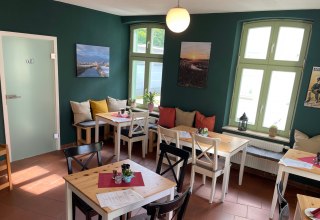Eixen Church is a 13th century village church in the municipality of Eixen in Western Pomerania. The church was built from field stones.
The church was probably dedicated to St. George. After being closed for static reasons, it was completely renovated and refurbished in 1992/93. Many people, institutions and companies from near and far helped. In 1248 Eixen (the name goes back to the knight Heinrich de Ecse, who settled here with several peasants at the beginning of the 12th century) was transferred to the Bishop of Schwerin, but remained a Pomeranian territory. In this period of transition from Romanesque to Gothic, the church was also built of field and brick. Remarkable from the outside, besides the regular masonry, is the ornamental gable on the east side. On the north side there is an annex of a sacristy with a domed vault. A vault was also planned inside the church. This is evidenced by the shield arches, whose terminating molded stones are shaped as heads.
The medieval painting of the church was largely brought to light again. The painting of the window groups, the shield arches, the ceiling tile and the consecration crosses date from the 13th century, two figures on the east side (St. Christopher on the left, a saint on the right) and the coat of arms on the north side from the beginning of the 14th century. Of the church's furnishings, the late Gothic altar shrine (now on the south side of the church) deserves attention first. This winged altar with figures of saints, the coronation of Mary and St. George on the front and panel paintings on the back was the main altar of the church, carved around 1530 probably in Lübeck. In front of the entrance to the churchyard there are old gravestones from 1742-1801. The cemetery with the rebuilt fieldstone wall gives a beautiful picture around the church.





















